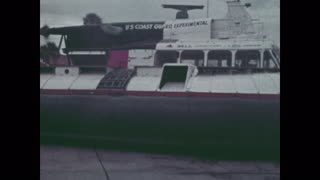This color film CGMP 11-71 is about the Air Cushion Vehicle (ACV) and its eight-month evaluation in 1971 for use with the Coast Guard. It is presented by the Department of Transportation and the U.S. Coast Guard. An Experimental Bell SK-5 Coast Guard air cushion vehicle hovercraft glides on top of the waves. It moves up onto the land. Others are briefly shown (:32-1:54). In 1969, the Coast Guard Station in St. Petersburg evaluated one for use. The back rudders, propeller, and hull are shown. The propellers are turned on and the craft lifts up from the ramp before entering the water at Tampa Bay (1:55-2:53). It is shown crossing the beach and back into the water, as well as in the marshlands (2:54-3:26). Fort Point Coast Guard Station in San Francisco is shown from overhead and its sign, where the ACV was also researched. The spinning propellers are shown (3:27-3:52). An ACV is guided into the water on search-and-rescue missions. A man stands holding a red smoke flair on the deck of his boat. The Coast Guard ACV arrives, tosses the man a line, and tows the boat in. A downed pilot holds red smoke flares while treading water and is rescued (3:53-5:35). The ACV ferries repair personnel to service a buoy, which it can pull directly next to (5:42-6:29). The driver’s feet are shown operating directional controls (6:32). An ACV carries bales of straw to a beach area threatened by an oil spill. A woman carries a shovel of straw into the water (6:35-6:42). The ACV pilot wears a helmet. He presses buttons and turns on switches (6:44-7:03). During frigid conditions, an ACV leaves a hangar in Point Barrow, Alaska in 1970. It is shown zipping across the ice, stops, spins, and moves on (7:05-8:06). An ACV is shown moving through waves, with spray flying around it (8:07-8:27).
This film and the ACV was an outgrowth of 1960s interest within the Coast Guard as to the feasibility of obtaining Air Cushion Vehicles (ACVs) to support a variety of Coast Guard missions. When three SK-5 ACVs, no longer required for the naval mission in Vietnam, became available in late 1969 the Coast Guard elected to conduct an expanded ACV evaluation program. The hovercraft were overhauled in the summer of 1970. Two ACVs, the first arriving in October of 1970 were assigned to the Fort Point Coast Guard Station, San Francisco, California. The third was utilized for Arctic Trials at Point Barrow Alaska.
The SK-5 was 38 feet 10 inches long with a beam of 23 feet 9 inches and was 15 feet 11 inches in height. The cabin supported a crew of three consisting of an Operator, Radar/Navigator, and a SAR crewman. The SK-5 could comfortably carry six passengers or an appropriate amount of cargo. The craft had a maximum speed of 70 knots and a range of 300 nautical miles. It was powered by a General Electric LM100 Marine Gas Turbine rated at 1050 shaft horsepower. A four-bladed, variable pitch aviation propeller provided thrust and seven foot diameter centrifugal supplied the air cushion. Both fan and propeller were driven off the same engine.
The evaluation report recognized that the ACV would not replace the utilization of boats and aircraft due to some operational limitations the ACV had that were not present in the other craft. The report did, however, conclude that the air cushion vehicle could and should play a significant role in the Coast Guard. It went on to illustrate that used in concert with small boats and aircraft, the Coast Guard would be able to provide a more effective response capability at less cost.
The Coast Guard did not procure ACVs. The capability was not disputed but it was recognized that newer and more advanced and more expensive hovercraft would have to be procured.
Incidentally, during the Vietnam War units similar to the SK-5 were used as Patrol Air Cushion Vehicle (PACV). The PACV was based on Bell Aerosystems Bell SK-5 hovercraft; a licensed version of the British Saunders-Roe (later, British Hovercraft Corporation) SR.N5 hovercraft. The SK-5 was adapted for American military use in 1965. Three were purchased by the U.S. Navy for operations in the emerging Vietnam War. Training of PACV crews was performed in the waters off Coronado, California near San Diego.
We encourage viewers to add comments and, especially, to provide additional information about our videos by adding a comment! See something interesting? Tell people what it is and what they can see by writing something for example: “01:00:12:00 — President Roosevelt is seen meeting with Winston Churchill at the Quebec Conference.”
This film is part of the Periscope Film LLC archive, one of the largest historic military, transportation, and aviation stock footage collections in the USA. Entirely film backed, this material is available for licensing in 24p HD, 2k and 4k. For more information visit http://www.PeriscopeFilm.com


